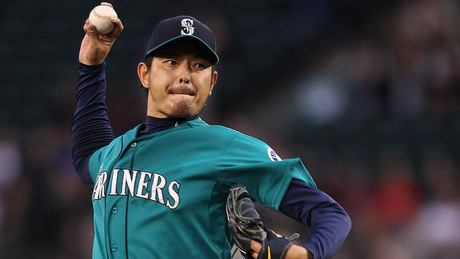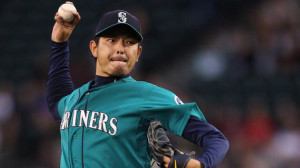Sleeper Scout: Mike Minor and Hisashi Iwakuma


After being selected seventh overall in the 2009 Amateur Draft, Mike Minor has seen more bad days than good ones in Atlanta. Even though his strikeout numbers have been more than respectable, his career 4.37 ERA and 1.30 WHIP leave much to be desired. Minor started 30 games for the Braves last year, his first full season in the majors, and posted career-bests in ERA (4.12), WHIP (1.15) and hits per nine innings (7.6), as well as in ERA+ (97), which means he was just below being a league-average pitcher. His K/9, BB/9 and HR/9 weren’t as good as previous years, but his strikeout rate was just a tad below league-average while his walk and home run rates were close to his career minor league numbers and shouldn’t be any worse this year.
The first number mentioned above that stands out is Minor’s WHIP of 1.15. He finished 16th among qualified starters in WHIP last year, ahead of Mat Latos, Jonny Cueto, Zack Greinke and many other more dominant starters. So why was Minor’s ERA so high while his WHIP was so good? Well, despite posting a stellar 30:8 K:BB in April, Minor had a 4.68 ERA thanks largely to a ridiculously low 56 percent left on base rate. The league average LOB% is around 71 percent. Minor’s overall 2012 LOB% ended up being just over 70 percent, much more in line with the league average. Minor was very good in pretty much every other statistic in his April numbers, but he just got unlucky with when he was giving up hits and when runners were on base. Minor’s two worst months were May and June, where he posted ERAs of 9.95 and 4.55, respectively, with a terrible 42:30 K:BB. He gave up 15 home runs in those two months and walked 12 percent of batters faced. There’s no excuse to those numbers, which aren’t even backed up by FIP, xFIP, etc. He’s a fly-ball pitcher prone to home runs, and he gave up a lot of them.
But enough of the bad news. Once the calendar flipped to July, Minor went nuts.
| Months | Innings | ERA | WHIP | K:BB | K% | BB% | HR/9 |
|---|---|---|---|---|---|---|---|
| April-June | 85.2 | 6.2 | 1.47 | 1.89 | 19 | 10 | 1.89 |
| July-Sept | 93.2 | 2.21 | 0.86 | 4.05 | 20 | 5 | 0.76 |
Minor increased his strike percentage, from 61 to 63, over that same time span, and he limited hitters to a .241 OBP from July-on, compared to a .271 average in April through June. Comparing May and September – Minor’s worst and best months – there was no drastic change in Minor’s pitch selection. He still used each of his four pitches a fairly similar amount of time. I chalk up Minor’s strong second half to him maturing, learning how to pitch better and getting a little lucky (or maybe just less unlucky than what he was in the first half).
Now, will he have a 2.21 ERA this year? Obviously that’s doubtful. But his ERA should be closer to 3.12 than his 2012 ERA of 4.12. He’s just 25, has four good pitches and is coming off the best few months of his career. Like I said, he’s homer-prone and has an occasional bout of wildness, but he’s more than just a solid pitcher. His current ADP at Mock Draft Central is 184, behind Ryan Vogelsong and Tim Hudson. Neither of those guys has near the upside Minor has, so when you need a fourth or fifth starter, take Minor.
A guy being drafted even later than Minor is Hisashi Iwakuma, a 31-year-old who pitched well as a rookie last year in Seattle. He’s currently being drafted 215th overall, which sets you up for a nice profit in his first full year as a starter. Iwakuma’s first 14 appearances last year were in relief, but from July 2-on he was a nice guy to have on your roster, as he made 16 starts with a 2.65 ERA, 1.23 WHIP and a 7.38 K/9. All three of those numbers were better than the numbers he put up in relief, making his solid year-end stats pale in comparison to his stellar starting numbers.
Iwakuma won’t wow you over with his stuff. His walk, strikeout, swinging strike and contact rates are all almost right at league average. But he does induce ground balls – lots of them. His 52.2 percent ground ball rate was 13th best among pitchers with at least 100 innings. And he only gave up fly balls 27.3 percent of the time, which was 11th best last year. That’s due mostly to his sinker and split-finger, which, for example, he threw 45 and 18 percent of the time, respectively, last June, according to Brooks Baseball. Those two pitches induced ground balls on 80 and 75 percent of balls in play during that month, respectively. If he relies on those pitches this year, he should be able to put up good numbers again in a starting role even with the SafeCo Field fences moving in.
Iwakuma doesn’t have the upside Minor or other pitchers do, but if you don’t draft starters early and want a fairly safe option in the later rounds, Iwakuma can be it thanks to his batted-ball profile.





